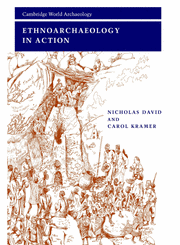Book contents
- Frontmatter
- Dedication
- Contents
- List of figures and credits
- List of tables
- Preface
- Acknowledgments
- Map
- 1 Ethnoarchaeology: its nature, origins, and history
- 2 Theorizing ethnoarchaeology and analogy
- 3 Fieldwork and ethics
- 4 Human residues: entering the archaeological context
- 5 Fauna and subsistence
- 6 Studying artifacts: functions, operating sequences, taxonomy
- 7 Style and the marking of boundaries: contrasting regional studies
- 8 Settlement: systems and patterns
- 9 Site structures and activities
- 10 Architecture
- 11 Specialist craft production and apprenticeship
- 12 Trade and exchange
- 13 Mortuary practices, status, ideology, and systems of thought
- 14 Conclusions: ethnoarchaeology in context
- Bibliography
- Index
6 - Studying artifacts: functions, operating sequences, taxonomy
Published online by Cambridge University Press: 05 March 2015
- Frontmatter
- Dedication
- Contents
- List of figures and credits
- List of tables
- Preface
- Acknowledgments
- Map
- 1 Ethnoarchaeology: its nature, origins, and history
- 2 Theorizing ethnoarchaeology and analogy
- 3 Fieldwork and ethics
- 4 Human residues: entering the archaeological context
- 5 Fauna and subsistence
- 6 Studying artifacts: functions, operating sequences, taxonomy
- 7 Style and the marking of boundaries: contrasting regional studies
- 8 Settlement: systems and patterns
- 9 Site structures and activities
- 10 Architecture
- 11 Specialist craft production and apprenticeship
- 12 Trade and exchange
- 13 Mortuary practices, status, ideology, and systems of thought
- 14 Conclusions: ethnoarchaeology in context
- Bibliography
- Index
Summary
A spade is a spade is a spade.
(Gertrude Stein)A spade is never so merely a spade as the word spade would imply.
(Christopher Fry)If [archaeologists] are to realize their avowed aim of reconstructing past decision making, they will have to stop looking back from their present position in time, trying to recognize in the past patterns that are observed in the present. They will have to travel back in time and look forward with those whom they study.
(Sander van der Leeuw 1991: 13)Archaeological and ethnoarchaeological approaches
Ethnoarchaeologists have contributed by providing descriptions of ethnographic specimens – archaeological ethnography (sensu Kent) – to the identification of archaeological artifacts and, through ethnoarchaeology, to interpretation of many aspects of their significance. We shall discuss examples, but need first to answer two not so simple questions: what are artifacts and what do archaeologists hope to learn from them? An artifact is something culturally fashioned, arranged, or substantially modified by humans, for example a basket, a circle of unworked megaliths, or the mark of a plough on a buried land surface. Although the concept covers machines and facilities – airplanes, traps, buildings, and the like – we are concerned in this chapter rather with small, transportable objects, tools, weapons, clothing, and decorative items.
- Type
- Chapter
- Information
- Ethnoarchaeology in Action , pp. 138 - 167Publisher: Cambridge University PressPrint publication year: 2001

